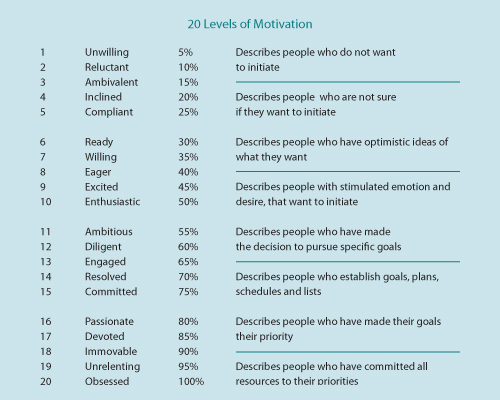Another one of my favorite analogies: what one can do; another can do. But all too often, the reality is that it is not what one can do; the challenge lies more in, what one will do. Initiative is the deciding factor between wishes, dreams and results.
Initiative: 1 energy or aptitude displayed in initiation of action. 2 ability to assess and initiate independently: using imagination and common sense. 3 the power or opportunity to act or take charge. 4 the act or strategy intended to resolve a difficulty or improve a situation; fresh approach.
“Initiative is the agent which translates imagination into action.”
General Lyman L. Lemnitzer
Initiative is exemplified in determining what needs to be done and in taking all of the necessary steps toward getting it done. To implement initiative, we often have to break through beliefs, insecurities and cycles that dilute our confidence and willingness to act. This requires an attitude of responsibility and a determination to seek out what is needed. It also requires confidence and trust in one’s abilities and judgment. Incidentally, the application of initiative, exercising the ability to solve a problem or to launch a creative plan, is one of the core skills of leadership… and true leadership begins with self.
There is a popular movie, set in 17th century England, where the plot finds a young English commoner dreaming that he can change his stars, (his destiny) and become a knight. While this scenario was impossible in that time and place, it is the making of the American Dream – where we are neither destined nor bound by our birth class. Our only true limitations lie within our desire and/or ability to develop resources and initiate a plan to lead the way to our chosen destiny. The ability to lead, like any other skill, must be developed and practiced; the more it is practiced, the more it produces. While only a small percentage of people develop this ability to its full potential, it exists within each of us.
By applying each of the eight principles in this series (motivation, goals, priorities, plans, organizing, initiative, obstacles and navigation), a person initiates all of the tasks necessary to lead. It does not matter if you apply the principles to organize your life, achieve personal goals, or to build an empire; by applying these principles, you have engaged in the process of initiating organized cause and effect… to develop desired results. The more one masters the application, the more one develops the skills to lead, whether it is for an army of one, or many.
Time is oblivious to man’s desire and will never change his circumstance. Great progress is born of great opportunity. Initiative involves both seeking and taking advantage of that opportunity. Leadership, with decisive courage and initiative, brings change. The principles never change, rather the level of potential, skill and results evolve.
To more effectively discuss initiative, we should revisit the discussion of motivation. In Part I of this series (in the March 2013 issue of DERMASCOPE), we learned about intrinsic motivations, where the focus is on the way we feel, and extrinsic motivations are where we focus on the result. We also discussed approach/avoidance motivations as well as incentive/reinforcement motivations. To further that discussion, I have developed a chart (listed below) showing the different levels of motivation.
This chart is segregated into four groups (of five levels) which describe increasing levels of motivation. Each level makes transitions from having schedules and lists provided to becoming the provider. It demonstrates that as one’s level of motivation increases, so does the initiative to lead. The percentages are provided as a reference to the amount of relative motivation that could potentially be provided.
Extrinsic motivation provides the most challenges for people. Providing additional challenge in the length of time and resources it may take to achieve long-term goals. In each case, initiative becomes even more important to battle the obstacles and distractions. In other words, the less personal pleasure that is involved in the pursuit of a goal and the longer commitment term required, the more initiative is required and the more your skills and resolve are tested. Most long-term goals require you to engage in situations you would rather avoid, which increases the difficulty and requires additional initiative. Intrinsic, approach and incentive motivation responses tend to be based on more short-term considerations. Extrinsic, avoidance and reinforcement motivations tend to be more long-term considerations.
It would be great to provide you with some magic words that can create high levels of motivation. It would be more incredible to have initiative that automatically matches our desire. The simple truth is that motivation and initiative are choices we can make. For each of us, these choices can be more or less challenging. Each of us have different conditioning based upon our beliefs and past experiences. The vast majority of successful people have conditioned themselves to be disciplined in these choices.
I have dozens of mantras or positive reinforcement motivational thoughts that I turn to when faced with extrinsic challenges I wish to avoid. I have used positive imagery from song lyrics, famous quotes and common colloquialisms that I have learned along the way. I do not think the specific chosen thoughts are as important as the process of conditioning oneself to have positive reinforcing motivational thoughts. The more this becomes practiced, the more it becomes habit. Remember, emotions are energy. Adding intentional positive energy to all your efforts can only push your results in a positive direction.
“Initiative is doing the right things without being told.”
Elbert Hubbard
“Take stands, take risks, take responsibility.”
Muriel Siebert
“Don’t wait for your ship to come in, swim out to it.”
Cathy Hopkins
“Success comes to the person who does today what you were thinking about doing tomorrow.”
Author Unknown
“Eagles don’t flock.”
Ross Perot
Practical Application
To practice applying initiative, start with projects or goals you have already begun that have stalled out. Make a list of things you have procrastinated about but want to accomplish. On each item, ask yourself why you did not complete the goal. Prioritize the list in order of importance or where you could make the most impact or progress. Choose an item from the list and write it down as a goal. Write a plan to achieve the goal. Put a realistic deadline to the plan. List the resources and tasks necessary to achieve the goal. Convert the list to a schedule, outlining the tasks with the time devoted to the goal. Whenever you feel discouraged or compelled to avoid a task at the prescribed time, practice reminding yourself why the goal is important. Focus on thoughts that will reinforce your desire to complete the task. Practice disciplining yourself to make these tasks a priority and always follow through. Accomplishing the specific task carries even more importance because you are conditioning yourself to be disciplined toward extrinsic motivations and accomplishing something important to you.
Next, we will discuss Obstacles. Our greatest obstacles tend to be ourselves. This will bring emotions, feelings and beliefs into the conversation, as they are the most significant obstacles we face. Indeed, it is not the outside forces that pose the greatest threat to our potential.
 William Strunk is the publisher of DERMASCOPE Magazine, founder of WES Publishing Co., founding partner with Avalon Media Group and a partner with the International Congress of Esthetics & Spa. As an entrepreneur for over 30 years, an author and lecturer, Strunk conducts motivational seminars and results oriented workshops on successful business practices. Having started his first business as a teenager, he shares successful behavioral practices that are not taught in business schools. Rather, learned from a lifetime devoted to motivational training and developing relationships with hundreds of other
William Strunk is the publisher of DERMASCOPE Magazine, founder of WES Publishing Co., founding partner with Avalon Media Group and a partner with the International Congress of Esthetics & Spa. As an entrepreneur for over 30 years, an author and lecturer, Strunk conducts motivational seminars and results oriented workshops on successful business practices. Having started his first business as a teenager, he shares successful behavioral practices that are not taught in business schools. Rather, learned from a lifetime devoted to motivational training and developing relationships with hundreds of other
successful entrepreneurs.
